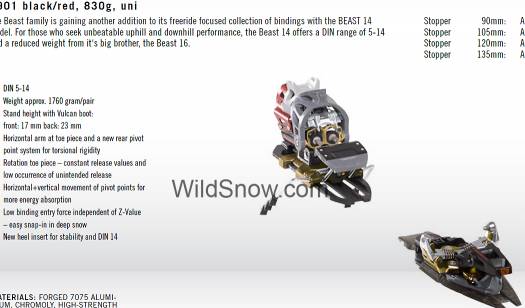As we’ve covered before, getting certified for DIN/ISO 13992 for a frameless “tech” binding is not easy, and it does have meaning, though perhaps not as much importance as a company might attach to it in a PR push. Caveat is to remember that 13992 is quite limited as to showing how elastic a binding is, and it has some strange stuff when asked to address frameless bindings, like a test of snow wadded up under your boot sole simulated by a spacer, when most tech bindings have plenty of space for that.
Edited press release follows:
TÜV CERTIFICATION ALSO APPROVED FOR BEAST 14 BINDING
Following the successful certification of the Beast 16 binding last winter, ski touring specialist DYNAFIT has also achieved the sought-after “TÜV” quality seal based on DIN ISO 13992 standards for Beast 14. Once again, DYNAFIT underscores its expertise as the ski touring binding specialist. The all-round Beast 14 binding speaks to serious athletic ski mountaineers who above all else seek ideal performance on descents on any terrain. The Beast 14 combines the frameless system with high strength and a release value (DIN) of 14. At 795 grams, it fits in the segment of classic ascent bindings, but it still offers all of the features of a sturdy freeride binding. It combines the patented pivoting toe piece of the Radical 2 at the front, with the heel unit technology of its big brother, the Beast 16.
(Be it known that an earlier Dynafit binding version achieved TÜV certification way back in 1994: The TLT4 was certified based on the then-current standards for touring bindings, DIN 7891, which preceded the current DIN ISO 13992. It thus was the first pin-based ski touring binding with the TÜV seal, though not to current standard 13992.)
WildSnow.com publisher emeritus and founder Lou (Louis Dawson) has a 50+ years career in climbing, backcountry skiing and ski mountaineering. He was the first person in history to ski down all 54 Colorado 14,000-foot peaks, has authored numerous books about about backcountry skiing, and has skied from the summit of Denali in Alaska, North America’s highest mountain.

